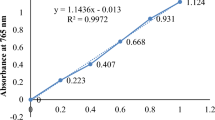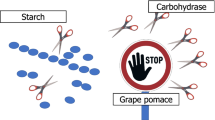Abstract
The ash gourd (AG) is a popular vegetable used widely for anti-diabetic and anti-obese properties. In the current investigation, the juice of AG pulp was screened for α-glucosidase inhibition. The result showed that the AG juice exhibited α-glucosidase inhibition in the range of 0.46 ± 0.00 to 1.61 ± 0.00 mg/mL as against standard drug acarbose showing inhibition at 0.17 ± 0.56 mg/mL. The study demonstrated that the AG juice may act as an effective, moderately potent inhibitor of α-glucosidase. These results indicate the presence of phytochemicals in AG juice that contribute as α-glucosidase inhibitors. This paper also discusses AG juice powder developed by spray drying with maltodextrin (MD) and gum arabic (GA) as anticaking agents. We observed that the spray-dried juice retained the α-glucosidase inhibition property. It was observed that the powder properties were better with AG juice in combination with MD, whereas AG juice with GA showed better α-glucosidase inhibition. Total polyphenol [19.15 ± 2.03 mg gallic acid equivalent/g (GAE/g)] and flavonoid [16.71 ± 1.5 mg quercetin equivalent/g (QE/g)] content were more in spray-dried powder containing GA.




Similar content being viewed by others
Data availability
Not applicable.
Abbreviations
- AG:
-
Ash gourd
- ANOVA:
-
Analysis of variance
- CI:
-
Carr index
- DAD:
-
Diode array detector
- DE:
-
Dextrose equivalent
- DPPH:
-
2,2-Diphenyl-1-picrylhydrazyl
- FC:
-
Folin–Ciocalteu
- GA:
-
Gum arabic
- GA-AG:
-
Ash gourd powder containing GA
- GAE:
-
Gallic acid equivalent
- HA-E:
-
Hydro-alcoholic extraction
- HPLC:
-
High-pressure liquid chromatography
- HR:
-
Hausner ratio
- IC50 :
-
Half maximal inhibitory concentration
- LJP:
-
Lyophilized juice powder
- MD:
-
Maltodextrin
- MD-AG:
-
Ash gourd powder containing MD
- PDA:
-
Photo-diode array
- pNPG:
-
p-Nitrophenyl-α-d-glucopyranoside
- QE:
-
Quercetin equivalent
- RID:
-
Refractive index detector
- RT:
-
Retention time
- TFC:
-
Total flavonoid content
- TPC:
-
Total phenolic content
- UHPLC:
-
Ultra high-pressure liquid chromatography
- ρb :
-
Bulk density
- ρt :
-
Tapped density
References
E. Chimezie, C.A. Ogazie, I. Agbagwa, Anatomical and phytochemical studies on Benincasa hispida (Thunb.) Cogn. (Cucurbitaceae). Not. Sci. Biol. 11, 102 (2019)
S. Azid, W.R. Wan Ishak, Therapeutic benefits of commercially available gourd family in improvement and sustainability of human health. Int. J. Eng. Technol. 7, 164 (2018)
M.E. Jacob, N. Miniraj, Variability studies for quality characters in neikumbalam accessions. J. Trop. Agric. 56(1), 56–62 (2018)
A. Mahatma, M. Santhosh Kumar, A. Sonowal, Evaluation of antidiabetic potential of methanolic extract of Benincasa hispida in dexamethasone induced diabetic rats. Int. J. Med. Dent. Sci. Invent. 1(1), 07–17 (2014)
F. Zakariaa, W.I. Wan Rosli, S.H. Ng, M.S. Zain, M. Shazwan, W. Ahmad, W.A. Nizam, Assessment of glycaemic effect of Benincasa hispida aqueous extract in streptozotocin diabetic rats. Health Environ. J. 7(1), 1–12 (2016)
H.S. Ryu, S.J. Lee, W.K. Whang, Isolation of anti-diabetic active compounds from benincasae exocarpium and development of simultaneous analysis by HPLC-PDA. Molecules 27(1), 9 (2021)
V.S. Nimmy, A Comprehensive review on the nutritional and medicinal significance of Kushmanda or ash gourd as per ayurveda. Int. J. Ayurveda Pharm. Res. 9(12), 41–45 (2022)
D. Rapaka et al., Benincasa hispida alleviates amyloid pathology by inhibition of Keap1/Nrf2-axis: emphasis on oxidative and inflammatory stress involved in Alzheimer’s disease model. Neuropeptides 88, 102151 (2021)
S.A.R.A. Alsaadi, K.S. Abass, Benincasa hispida is an antioxidant of possible physiological importance: a comparative review. Plant Arch. 20(2), 2833–2838 (2020)
S.B. Unde, S.S. Dhavane, In vitro free radical scavenging activity of ash gourd and its potential ability to treat several severe diseases. World J. Pharm. Res. 11(1), 737–747 (2021)
P. Gupta, S. Chikkala, P. Kundu, Ash gourd and its applications in the food, pharmacological and biomedical industries. Int. J. Veg. Sci. 27, 1–10 (2019)
S. Palamthodi, D. Kadam, S.S. Lele, Physicochemical and functional properties of ash gourd/bottle gourd beverages blended with jamun. J. Food Sci. Technol. 56(1), 473–482 (2019)
P. Purohit, S. Palamthodi, S.S. Lele, Effect of karwanda (Carissa congesta Wight) and sugar addition on physicochemical characteristics of ash gourd (Benincasa hispida) and bottle gourd (Langenaria siceraria) based beverages. J. Food Sci. Technol. 56(2), 1037–1045 (2019)
N. Tran, B. Pham, L. Le, Bioactive compounds in anti-diabetic plants: from herbal medicine to modern drug discovery. Biology 9(9), 252 (2020)
Q. Guo et al., New research development on trans fatty acids in food: biological effects, analytical methods, formation mechanism, and mitigating measures. Prog. Lipid Res. 89, 101199 (2023)
J. Gawałek, Effect of spray dryer scale size on the properties of dried beetroot juice. Molecules 26(21), 6700 (2021)
G. Pistia-Brueggeman, R. Hollingsworth, A preparation and screening strategy for glycosidase inhibitors. Tetrahedron 57, 8773–8778 (2001)
B. Bazaria, P. Kumar, Comparative analysis of bio-polymers addition on structural and physical properties of spray dried beetroot juice concentrate. J. Food Process. Preserv. 41(6), e13232 (2017)
I.P. Turkiewicz et al., The influence of different carrier agents and drying techniques on physical and chemical characterization of Japanese quince (Chaenomeles japonica) microencapsulation powder. Food Chem. 323, 126830 (2020)
N. Jinapong, M. Suphantharika, P. Jamnong, Production of instant soymilk powders by ultrafiltration, spray drying and fluidized bed agglomeration. J. Food Eng. 84(2), 194–205 (2008)
M.Z. Islam et al., Micro wet milling and spray drying of whole mandarin powder and its characterization. J. Food Meas. Charact. 15(1), 851–861 (2021)
V.L. Singleton, J.A. Rossi, Colorimetry of total phenolics with phosphomolybdic-phosphotungstic acid reagents. Am. J. Enol. Vitic. 16(3), 144–158 (1965)
M.V. Reshma et al., Total phenol content, antioxidant activities and α-glucosidase inhibition of sesame cake extracts. J. Food Biochem. 37(6), 723–731 (2013)
W. Brand-Williams, M.-E. Cuvelier, C. Berset, Use of a free radical method to evaluate antioxidant activity. LWT Food Sci. Technol. 28(1), 25–30 (1995)
K.S. Veena et al., Development and validation of HPLC method for determination of sugars in palm sap, palm syrup, sugarcane jaggery and palm jaggery. Int. Food Res. J. 25, 649–654 (2018)
J. Chanda et al., Determination of cucurbitacin E in some selected herbs of ayurvedic importance through RP-HPLC. J. Ayurveda Integr. Med. 11(3), 287–293 (2020)
K. Papoutsis et al., Fruit, vegetables, and mushrooms for the preparation of extracts with alpha-amylase and alpha-glucosidase inhibition properties: a review. Food Chem. 338, 128119 (2021)
Q. Zhang et al., Dietary protein–phenolic interactions: characterization, biochemical-physiological consequences, and potential food applications. Crit. Rev. Food Sci. Nutr. 61(21), 3589–3615 (2021)
A. Selahvarzi et al., Evaluation of physicochemical, functional, and antimicrobial properties of a functional energy drink produced from agricultural wastes of melon seed powder and tea stalk caffeine. J. Food Process. Preserv. 45(9), e15726 (2021)
A. Selahvarzi et al., Investigation of antimicrobial activity of orange and pomegranate peels extracts and their use as a natural preservative in a functional beverage. J. Food Meas. Charact. 15(6), 5683–5694 (2021)
G.K. Sidhu, M. Singh, P. Kaur, Effect of operational parameters on physicochemical quality and recovery of spray-dried tomato powder. J. Food Process. Preserv. 43(10), e14120 (2019)
M. KhalilianMovahhed, M. Mohebbi, Spray drying and process optimization of carrot–celery juice. J. Food Process. Preserv. 40(2), 212–225 (2016)
Z. Emam-Djomeh, A. Seddighi, G. Askari, Influence of process conditions on the functional properties of spray-dried seedless black barberry (Berberis vulgaris) juice powder. J. Food Process. Preserv. 41(3), e12934 (2017)
M. Gallón Bedoya, M. Cortés Rodríguez, J.H. Gil, Physicochemical stability of colloidal systems using the cape gooseberry, strawberry, and blackberry for spray drying. J. Food Process. Preserv. 44(9), e14705 (2020)
R. Upadhyay, F.P. Dass, Physicochemical analysis, microbial survivability, and shelf life study of spray-dried synbiotic guava juice powder. J. Food Process. Preserv. 45(2), e15103 (2021)
M. GhalegiGhalenoe, D. Dehnad, S.M. Jafari, Physicochemical and nutritional properties of pomegranate juice powder produced by spray drying. Dry. Technol. 39(12), 1941–1949 (2021)
G. Miravet et al., Spray-drying of pomegranate juice with prebiotic dietary fibre. Int. J. Food Sci. Technol. 51(3), 633–640 (2016)
S. Saikia, N.K. Mahnot, C.L. Mahanta, Effect of spray drying of four fruit juices on physicochemical, phytochemical and antioxidant properties. J. Food Process. Preserv. 39(6), 1656–1664 (2015)
M. Sobulska, I. Zbicinski, Advances in spray drying of sugar-rich products. Drying Technol. 39(12), 1774–1799 (2020)
S.C. Chew, C. Tan, K. Nyam, Microencapsulation of refined kenaf (Hibiscus cannabinus L.) seed oil by spray drying using β-cyclodextrin/gum Arabic/sodium caseinate. J. Food Eng. 237, 78–85 (2018)
I. Md Zohurul, Micro wet milling and spray drying of whole mandarin powder and its characterization. J. Food Meas. Charact. 15(1), 851–861 (2021)
X. Chen et al., Comparing three types of mandarin powders prepared via microfluidic-jet spray drying: physical properties, phenolic retention and volatile profiling. Foods 10(1), 123 (2021)
M. Rosenberg, I. Kopelman, Y. Talmon, A scanning electron microscopy study of microencapsulation. J. Food Sci. 50, 139–144 (2006)
Acknowledgements
A. S. Athira acknowledges the Department of Science & Technology for providing the INSPIRE-SRF fellowship. We are also thankful to Dr. C.G Joshy, senior scientist, CIFT, Cochin for the valuable suggestions for statistical analysis.
Author information
Authors and Affiliations
Corresponding author
Ethics declarations
Conflict of interest
The authors declare no conflict of interest regarding this publication.
Additional information
Publisher's Note
Springer Nature remains neutral with regard to jurisdictional claims in published maps and institutional affiliations.
Supplementary Information
Below is the link to the electronic supplementary material.
Rights and permissions
Springer Nature or its licensor (e.g. a society or other partner) holds exclusive rights to this article under a publishing agreement with the author(s) or other rightsholder(s); author self-archiving of the accepted manuscript version of this article is solely governed by the terms of such publishing agreement and applicable law.
About this article
Cite this article
Athira, A.S., Reshma, M.V. Ash gourd (Benincasa hispida (Thunb.) Cogn.) juice as an α-glucosidase inhibitor and its spray-dried juice properties. Food Measure 18, 2598–2608 (2024). https://doi.org/10.1007/s11694-023-02339-z
Received:
Accepted:
Published:
Issue Date:
DOI: https://doi.org/10.1007/s11694-023-02339-z




